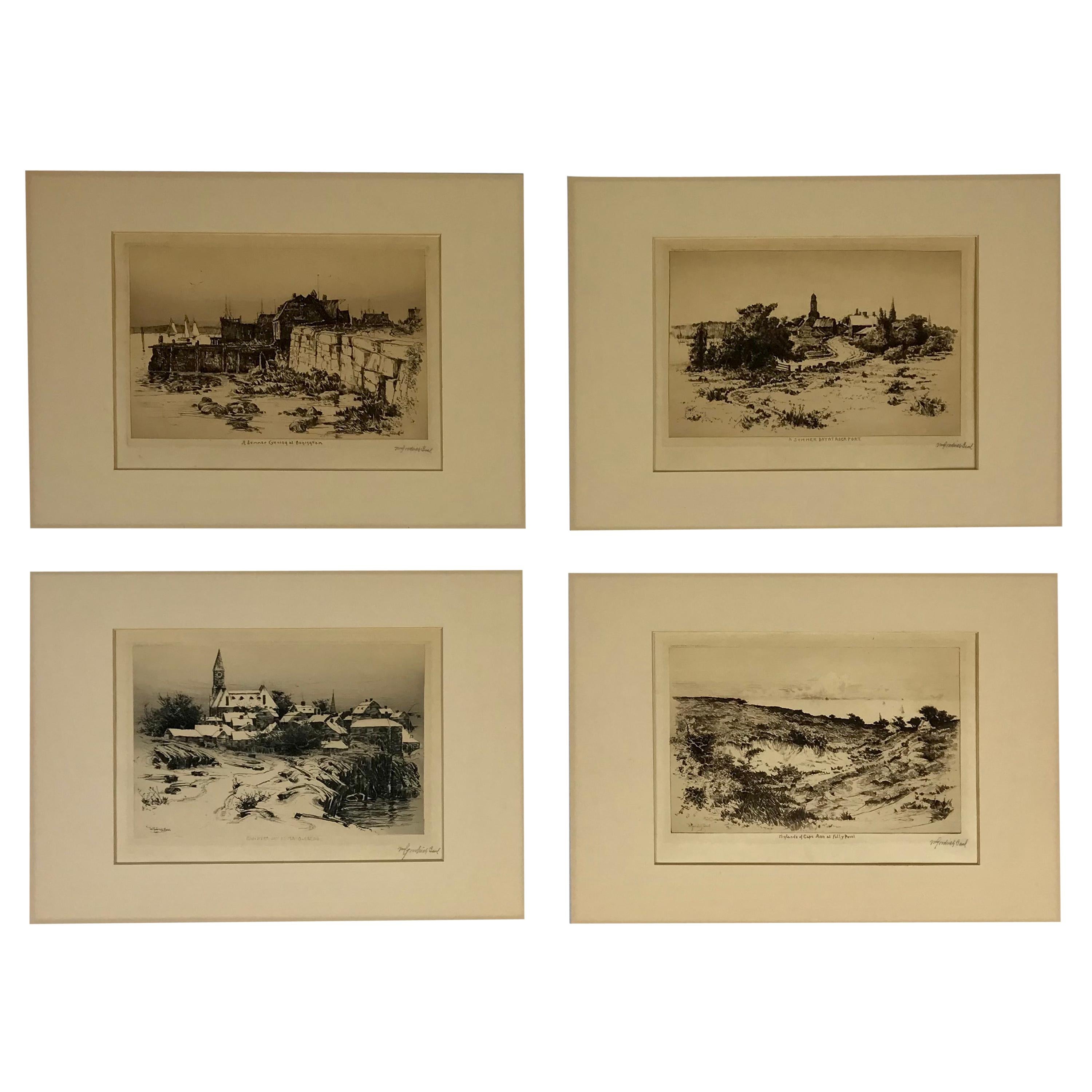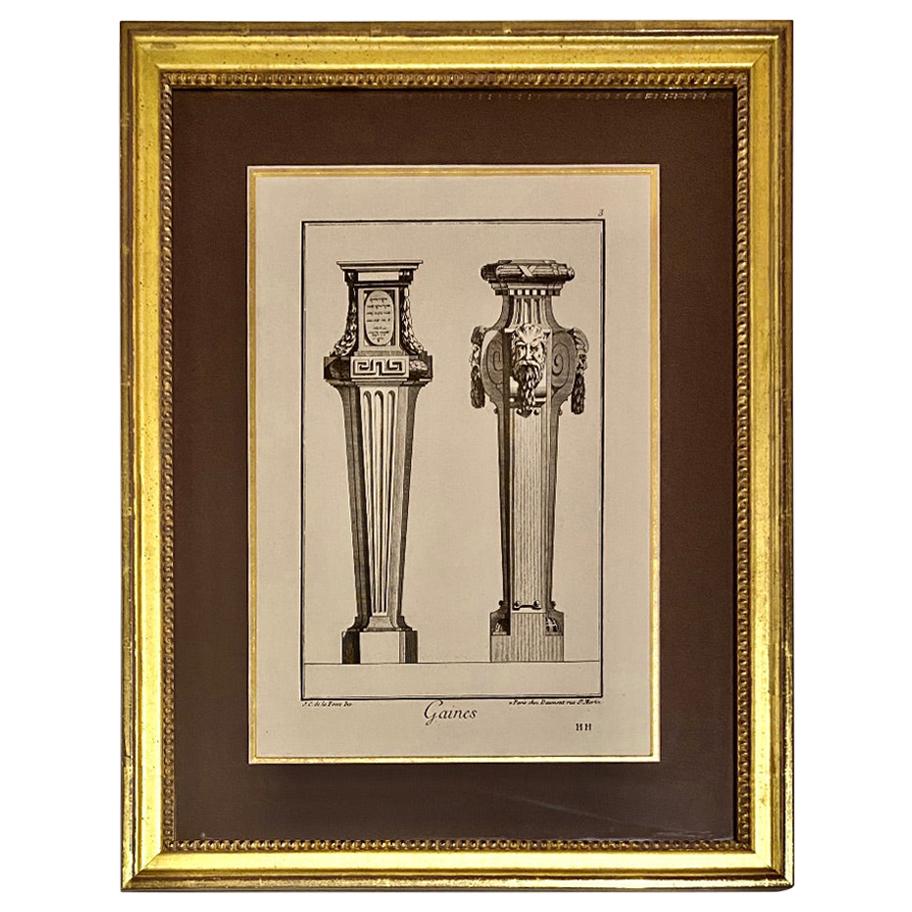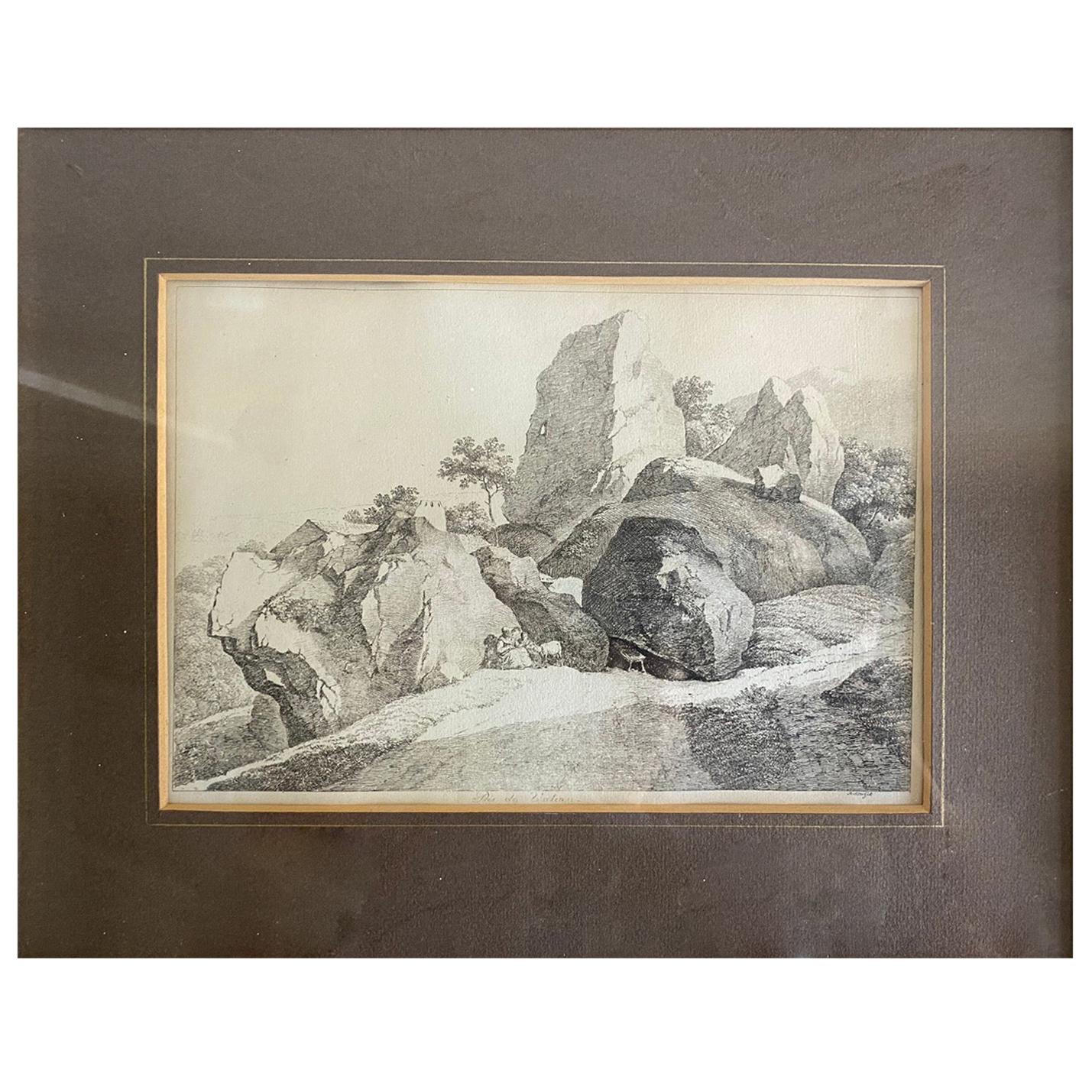Items Similar to James Jacques Joseph Tissot "Soirée d'été" 'Summer Evening' Etching & Dry Point
Want more images or videos?
Request additional images or videos from the seller
1 of 9
James Jacques Joseph Tissot "Soirée d'été" 'Summer Evening' Etching & Dry Point
About the Item
A fine French 19th century etching and drypoint Titled "Soirée d'été" (Summer Evening) by Jacques Joseph Tissot (French, 1836-1902) depicting Mrs. Kathleen Newton resting on a lounge chair. Signed and dated (l/l): J.J. Tissot, 1881 in the plate. Under the mat, the front of the sheet inscribed in pencil with a '1' in a circle, the verso of the sheet with old price inscription "450-" in pencil. Circa: 1881-1882.
Measures: Plate Height: 9 inches (22.9 cm)
Plate Width: 15 1/2 inches (39.4 cm)
Sheet Height: 14 1/2 inches (36.8 cm)
Sheet Width: 20 5/8 inches (52.4 cm)
Frame Height: 19 inches (48.3 cm)
Frame Width: 24 1/2 inches (62.2 cm)
Frame Depth: 1 1/8 inches (2.9 cm)
Literature:
Wentworth 56. Note: Tissot's from 1881 is said to depict his lover, the Irish divorcee Mrs. Kathleen Newton, resting on a lounge chair.
Provenance:
Private collection, Los Angeles, California
Jacques Joseph Tissot (French, 15 October 1836 – 8 August 1902), Anglicized as James Tissot, was a French painter and illustrator. He was a successful painter of Paris society before moving to London in 1871. He became famous as a genre painter of fashionably dressed women shown in various scenes of everyday life. He also painted scenes and characters from the Bible.
Jacques Tissot was born in the city of Nantes in France and spent his early childhood there. His father, Marcel Théodore Tissot, was a successful drapery merchant. His mother, Marie Durand, assisted her husband in the family business and designed hats. A devout Catholic, Tissot's mother instilled pious devotion in the future artist from a very young age. Tissot's youth spent in Nantes likely contributed to his frequent depiction of shipping vessels and boats in his later works. The involvement of his parents in the fashion industry is believed to have been an influence on his painting style, as he depicted women's clothing in fine detail. By the time Tissot was 17, he knew he wanted to pursue painting as a career. His father opposed this, preferring his son to follow a business profession, but the young Tissot gained his mother's support for his chosen vocation. Around this time, he began using the given name of James. By 1854 he was commonly known as James Tissot; he may have adopted it because of his increasing interest in everything English.
In 1856 or 1857, Tissot travelled to Paris to pursue an education in art. While staying with a friend of his mother, painter Elie Delaunay, Tissot enrolled at the Ecole des Beaux-Arts to study in the studios of Hippolyte Flandrin and Louis Lamothe. Both were successful Lyonnaise painters who moved to Paris to study under Jean-Auguste-Dominique Ingres. Lamothe provided the majority of Tissot's studio education, and the young artist studied on his own by copying works at the Louvre, as did most other artists of the time in their early years. Around this time, Tissot also made the acquaintance of the American James McNeill Whistler, and French painters Edgar Degas (who had also been a student of Lamothe and a friend of Delaunay), and Édouard Manet.
In 1859, Tissot exhibited in the Paris Salon for the first time. He showed five paintings of scenes from the Middle Ages, many depicting scenes from Goethe's Faust. These works show the influence in his work of the Belgian painter Henri Leys (Jan August Hendrik Leys), whom Tissot had met in Antwerp earlier that same year. Other influences include the works of the German painters Peter Von Cornelius and Moritz Retzsch. After Tissot had first exhibited at the Salon and before he had been awarded a medal, the French government paid 5,000 francs for his depiction of The Meeting of Faust and Marguerite in 1860, with the painting being exhibited at the Salon the following year, together with a portrait and other paintings.
Émile Péreire supplied Tissot's painting Walk in the Snow for the 1862 international exhibition in London; the next year three paintings by Tissot were displayed at the London gallery of Ernest Gambart.
In about 1863, Tissot suddenly shifted his focus from the medieval style to the depiction of modern life through portraits. During this period, Tissot gained high critical acclaim, and quickly became a success as an artist. Like contemporaries such as Alfred Stevens and Claude Monet, Tissot also explored Japonisme, including Japanese objects and costumes in his pictures and expressing style influence. Degas painted a portrait of Tissot from these years (Metropolitan Museum of Art, New York), in which he is sitting below a Japanese screen hanging on the wall.
Still on Top, 1873
Tissot fought in the Franco-Prussian War as part of the improvised defense of Paris, joining two companies of the Garde Nationale and later as part of the Paris Commune. His 1870 painting La Partie Carrée (The Foursome) evoked the period of the French revolution. Either because of the radical political associations related to the Paris Commune (which he was believed to have joined mostly to protect his own belongings rather than for shared ideology), or because of better opportunities, he left Paris for London in 1871. During this period, Seymour Haden helped him to learn etching techniques. Having already worked as a caricaturist for Thomas Gibson Bowles, the owner of the magazine Vanity Fair, as well as exhibited at the Royal Academy, Tissot arrived with established social and artistic connections in London. Tissot used the name Coïdé in Vanity Fair from 1869 to 1873.
Tissot quickly developed his reputation as a painter of elegantly dressed women shown in scenes of fashionable life. By 1872 Tissot had bought a house in St John's Wood, an area of London very popular with artists at the time. According to The Oxford Dictionary of Art and Artists, "in 1874 Edmond de Goncourt wrote sarcastically that he had 'a studio with a waiting room where, at all times, there is iced champagne at the disposal of visitors'".
He gained membership of The Arts Club in 1873.
Paintings by Tissot appealed greatly to wealthy British industrialists during the second half of the 19th century. During 1872 he earned 94,515 francs, an income normally only enjoyed by those in the echelons of the upper classes.
In 1874, Degas asked him to join them in the first exhibition organized by the artists who became known as the Impressionists, but Tissot refused. He continued to be close to these artists, however. Berthe Morisot visited him in London in 1874, and he travelled to Venice with Édouard Manet at about the same time. He regularly saw Whistler, who influenced Tissot's Thames river scenes.
In 1875–76, Tissot met Kathleen Newton, a divorcee who became the painter's companion and frequent model. He composed an etching of her in 1876 entitled Portrait of Mrs N., more commonly titled La frileuse. She gave birth to a son, Cecil George Newton in 1876, who is believed to be Tissot's son. She moved into Tissot's household in St. John's Wood in 1876 and lived with him until her death in the late stages of consumption in 1882. Tissot frequently referred to these years with Newton as the happiest of his life, a time when he was able to live out his dream of a family life.
After Kathleen Newton's death, Tissot returned to Paris. A major exhibition of his work took place in 1885 at the Galerie Sedelmeyer, where he showed 15 large paintings in a series called La Femme à Paris. Unlike the genre scenes of fashionable women he painted in London, these paintings represent different types and classes of women, shown in professional and social scenes. The works also show the widespread influence of Japanese prints, as he used unexpected angles and framing from that tradition. He created a monumental context in the size of the canvases. Tissot was among many Western artists and designers influenced at the time by Japanese art, fashion and aesthetics.
References & Exhibitions:
References: Henri Beraldi, Les Graveurs du XIX Siecle (Paris: 1885).
Michael Justin Wentworth, James Tissot - Catalogue Raisonne of His Prints (Minneapolis, MN; Minneapolis Institute of Arts, 1978).
Christopher Wood, Tissot: The Life and Work of Jacques Joseph Tissot, 1836-1902 (London: Weidenfeld & Nicolson Ltd., 1986).
- Creator:James Tissot (Painter)
- Dimensions:Height: 19 in (48.26 cm)Width: 24.5 in (62.23 cm)Depth: 1.13 in (2.88 cm)
- Style:Victorian (In the Style Of)
- Materials and Techniques:
- Place of Origin:
- Period:
- Date of Manufacture:circa 1881-1882
- Condition:Wear consistent with age and use. Toned. The sheet somewhat unevenly trimmed along the bottom edge as it measures 14 3/8 inches at the right end and 14 1/2 inches at the left. I very good overall condition. The frame is later. Please view all images.
- Seller Location:Los Angeles, CA
- Reference Number:
James Tissot
James Jacques Joseph Tissot (October 15, 1836 - August 8, 1902) was a French painter. Tissot was born at Nantes. He studied at the Êcole des Beaux-Arts in Paris under Ingres, Flandrin and Lamothe, and exhibited in the Paris Salon for the first time at the age of twenty-three. In 1855 Tissot moved to Paris where he studied under Jules-Élie Delaunay, Louis Lamothe and Hippolyte Flandrin. Lamothe, who had been a pupil of Ingres, introduced him to Edgar Degas. The two men became close friends. Another friendship formed at this time was with James McNeill Whistler. Two portraits, including one of Tissot's mother, were among the artist's first exhibits at the Paris Salon in 1859. In 1861 he showed The Meeting of Faust and Marguerite, which was purchased by the state for the Luxembourg Gallery. His first characteristic period made him a painter of the charms of women. Demi-mondaine would be more accurate as a description of the series of studies that he called La Femme à Paris. Tissot fought in the Franco-Prussian War, and, falling under suspicion as a Communard, left Paris for London. Here he studied etching with Sir Seymour Haden, drew caricatures for Vanity Fair, and painted portraits as well as genre subjects. Sometime in the 1870s Tissot met a divorcée, Mrs. Kathleen Newton, who became his muse and the model for many of his paintings.
About the Seller
5.0
Vetted Seller
These experienced sellers undergo a comprehensive evaluation by our team of in-house experts.
Established in 1982
1stDibs seller since 2016
114 sales on 1stDibs
Typical response time: <1 hour
- ShippingRetrieving quote...Ships From: Los Angeles, CA
- Return PolicyThis item cannot be returned.
More From This SellerView All
- Francis De Erdely Watercolor and Pencil "Mexican Shark Fisherman"By Francis De Erdely 2Located in Los Angeles, CAFrancis De Erdely (Hungarian/American, 1904-1959) “Mexican Shark Fishermen” water color and Pencil on Paper within a pine frame and protective glass, circa 1930. Signed: ‘De Erdely’...Category
Early 20th Century American Folk Art Paintings
MaterialsGlass, Pine, Paper
- Francesco Ballesio, a Fine Orientalist Pencil and WatercolorBy Francesco Ballesio 2Located in Los Angeles, CAFrancesco Ballesio (Italian, 1860-1923). A fine orientalist pencil and watercolor heightened with gum Arabic on paper figure of "A Middle-Eastern Beauty at Rest" depicting a young maiden resting on a Persian rug laid down as a bed while holding a tambourine and next to a Moroccan ivory-inlaid octagonal table with a tea pot on top. Signed and inscribed 'Ballesio Roma Tivoli' (upper right). All within an ornate rococo gilt wood and gesso carved frame with a protective glass, Rome, circa 1890-1900, Frame height: 23 inches (58.4 cm). Frame width: 30 1/2 inches (30.5 cm). Frame depth: 2 1/4 inches (5.7 cm). Paper height: 15 inches (38.1 cm). Paper width: 21 1/2 inches (54.7 cm). Literature: A similar subject matter watercolor is catalogued and illustrated in Caroline Juler, "Les Orientalistes...Category
Antique 1890s Italian Islamic Paintings
MaterialsGesso, Glass, Wood, Paper
- Henry Joseph Campotosto, Oil Canvas "Walking the Baby Goat"Located in Los Angeles, CAHenry Joseph Campotosto (Belgium, 1833-1910) A Very Fine Oil on Canvas "Walking the Baby Goat", depicting two young dutch girls by the grassy shore of a river bank, one standing holding a wicker basket and a leash to a resting baby goat, the youngest sitting next to her on a pile of branches tucking her pants, a pair of ducks and ducklings swimming by the tree lined river; within a later giltwood carved frame. Signed (l/r): Campotosto Henry. Circa: Brussels, 1870. Note: The artist is also known as Henri Campotosto Henry or Henri Campotosto was born in Brussels in 1833. He studied in Brussels at the Royal Academy des Beaux-Arts and painted some artworks with Eugène Verboeckhoven (Belgium, 1798-1881). He received a 1st Class Medal at the Academy of Brussels and an honorable mention at the Paris Exhibition of 1860. In 1871 he moved to London with his family and remained there for life. He exhibited his work at the Royal Academy Exhibition until 1874 and at the Suffolk Street Gallery from 1878. In 1880 he took part in the Berlin Academy Exhibition. His daughter Octavia also became a painter, visited Italy, and showed her paintings at the Royal Academy from 1871 to 1874. Henri Campotosto died in London in 1910. High Sales: Christie's New York - Property from an American Collection, "The Bird's Nest" - Lot 247 on October 22, 2008, Sold for $37,500 Bonhams London - 19th Century European, Victorian and British Impressionist Art on 28 September 2016 - Lot 33 "Gathering flowers" Sold for £25,000 ($33,750 USD) Museums: The British Museum - Print of two girls and a lamb and print of two girls by a river bank Literature • E. Benezit Dictionnaire des Peintres, Sculpteurs, Dessinateurs, et Graveurs by Librairie Gründ - 1976 Edition - Volume 2, Page 488. • Maurice W...Category
Antique 19th Century Belgian Country Paintings
MaterialsCanvas, Giltwood
- Pair French Belle Époque Gilt-Bronze Cherub Wall-Lights, After Joseph ChéretBy Eugene SoleauLocated in Los Angeles, CAA fine pair of French Belle Époque figural gilt-bronze two-light wall-lights, after Gustave Joseph Chéret (French, 1838-1894) signed: Joseph Chéret, 25 and Stamped: Soleau-Paris. The...Category
Antique Early 1900s French Belle Époque Wall Lights and Sconces
MaterialsBronze
- Eugène Blot "An Evening at The Opera" Sculpture of a LadyBy Eugène BlotLocated in Los Angeles, CAEugène Blot (French, 1830-1899) "An Evening at The Opera House" a fine and rare French 19th century polychrome and parcel-gilt spelter figure of a lady sea...Category
Antique Late 19th Century French Rococo Revival Figurative Sculptures
MaterialsSpelter
- Pair French Mid-Century Ebonized Metal Armchairs manner of Jacques Adnet- HermèsBy Jacques AdnetLocated in Los Angeles, CAA rare pair of French Mid-Century designer ebonized metal painted armchairs with forged decorative castings representing faux leather equestrian strap straps with buckles and rings, ...Category
Mid-20th Century French Mid-Century Modern Armchairs
MaterialsMetal, Wrought Iron
You May Also Like
- 4 Etchings by WG Beal, Marblehead, Rock Port, Folly Point & Annisquam, 1880's MALocated in Bedford Hills, NYSet of four etchings by American artist William Goodrich Beal, circa 1880s. Scenic Massachusetts coastal towns and beaches. All signed in pencil, lower right corner. American Arti...Category
Antique 1880s American American Classical Prints
MaterialsPaper
- James Joseph Kearns "Despondent Man" EtchingBy James Joseph KearnsLocated in Brooklyn, NYJames Joseph Kearns (b. 1924) etching, signed at dated "1957." Depicts a man with hollow eyes and a despondent expression with a hand outstretched. Similar to many of his works, ther...Category
Vintage 1950s American Modern Drawings
MaterialsPaper
- "Le Croquet" Etching and Drypoint 1878 French Artist Jacques TissotLocated in Toledo, OH"Le Croquet" etching and drypoint 1878 by French artist Jacques Tisset (1836-1902) on cream Japan paper. Young lady playing croquet with two reclining ladie...Category
Antique 1870s European Victorian Prints
MaterialsPaper
- Architectural Etching, Gaines 'Columns'Located in Montreal, QuebecArchitectural print Total of 6 available 2 horizontal & 4 vertical prints Dimensions: Frame: 16” W x 20.25” H x 1” D Etching: 9.5” W x 13.75” H.Category
Antique Late 19th Century French Neoclassical Prints
MaterialsWood, Paper
- Architectural Etching, Gaines 'Columns'Located in Montreal, QuebecArchitectural print Total of 6 available 2 horizontal & 4 vertical prints Dimensions: Frame: 16” W x 20.25” H x 1” D Etching: 9.5” W x 13.75” H.Category
Antique Late 19th Century French Neoclassical Prints
MaterialsWood, Paper
- Franz Xavier Lorenz EtchingLocated in Sheffield, MAEtching by V Franz Xaver Lorenz Rektorzik-Brunn 1793-1851 Etching 7 x 10.Category
Antique 19th Century European Prints
MaterialsPaper
Recently Viewed
View AllMore Ways To Browse
Japan Wall Screen
Japanese Wall Screens
Antique Evening Dress
Antique Evening Dresses
Learn Antique Furniture
Large Fashion Wall Prints
Victorian House Drawing
English Wood Wall Art
English Wall Hanging
Antique Victorian Lounge
Antique Wood Saw
St Joseph Antique
Minneapolis Furniture
Antique Dry Measure
Antique Dry Measures
Wall Hanging Japan
Etched Pictures
Tissot Used





